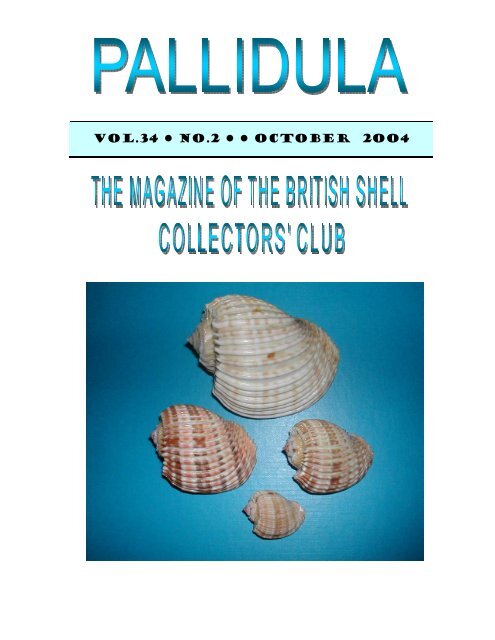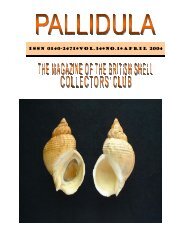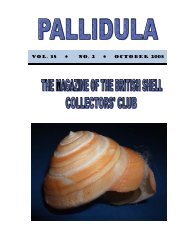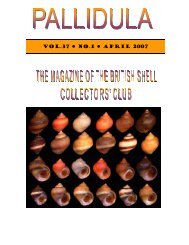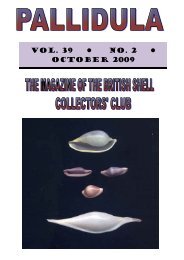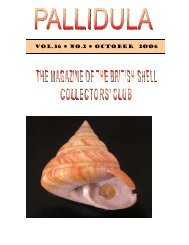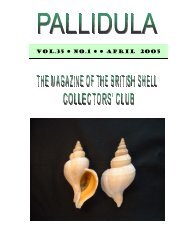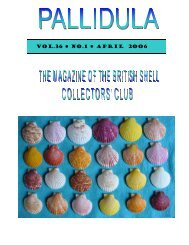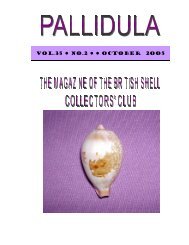October, 2004 - British Shell Collectors' Club
October, 2004 - British Shell Collectors' Club
October, 2004 - British Shell Collectors' Club
- No tags were found...
Create successful ePaper yourself
Turn your PDF publications into a flip-book with our unique Google optimized e-Paper software.
VOL.34 • NO.2 • • OCTOBER 2OO4
Page 2PALLIDULACOVER PAGEA beautiful set of Harpa costata (L. 1758). The largest is a huge 100mm specimen originating from the Geoff Coxcollection, collected in Reunion Island 45 years ago. These large sizes have not been collected for many years. Theother three were purchased in July <strong>2004</strong> from a dealer in Mauritius and were collected in Blue Bay, Mahebourg.Only one or two specimens of H. costata are now collected in the course of a year and they are becoming extremelyrare. All specimens pictured are in the collection of the Editor.
PALLIDULA Page 3The Beaches of South Africaby Gavin MalcolmTable MountainCape TownAs a collector of Cones and Olives and an absolute novice on any other species, then a vacation inSouth Africa was always going to be a challenge as we worked our way up the coast from CapeTown to Durban. So, armed with the book on beach Marine <strong>Shell</strong>s of South Africa by Douw Steynand Marcus Lussi, we headed out.South Africa has some fabulous tourist sites to visit; the unsurpassable view from Table Mountain, theCape Peninsula, the Drakensberg mountains and most of all, the spectacular beaches.Our first couple of days in Cape Town were a great starting point, no clouds in the sky, and wequickly learned to do things the local way. If you are going to rent a car then all the big companiesare there but check the insurance terms carefully for high-jacking and theft cover. Most SouthAfricans are obsessed with security; every hotel has a guarded car park and every parking lot hasapproved local entrepreneurs to look after your parked car. Once you learn to pay the small fee andavoid any “unguarded” beaches then you can begin.So off we went to Hout Bay and Kommetjie down the west side of the Cape via Chapmans Peak tothe Atlantic beaches. Armed with a fishing licence from the Post Office, you can collect on mostbeaches. We stopped at the shell shop in Hout Bay to be greeted by the Scots-born owner from thesame village as ourselves. The shop was wall to wall Philippine specimens. One of the greatdisappointments of this trip was that few shell shops had any South African shells. Scuba diving isnot my thing and I avoid taking live shells so Kommetjie tide pool rocks were a good introduction formy collecting.My first two finds were probably the best: a fine specimen of Janthina janthina (Linneaus, 1758)followed by a large 39mm specimen of Janthina prolongata (Blainville, 1822), both vivid purple.Diloma impervia (Menke, 1834), Diloma variegata (Anton,1839) and Gibbula beckeri Sowerby, 1901were to become regular finds. Large specimens of black Diloma tigrina (Anton, 1839) wereeverywhere and we quickly learnt that limpets are outsize in South Africa with Patella granatinaLinneaus, 1758 weighing in at 70mm.As the sun set, we headed back to Hout Bay to visit with club member and dealer Alan Seccombe. Avisit to the shell wing of his house produced some fine cones for my collection but most of all, wewere given kind hospitality and good advice on where to go collecting and equally important a map tothe best wineyards in Stellenbosch for tasting. Alan is a goodjudge of wines.Sorry… No collecting hereNext day it was down the False Bay coast to Boulders to seethe penguins. The beach and rocks at the restaurant by thecar park proved very fruitful for shell collecting although thepenguins make it clear that shell collecting is not allowed intheir Nature Reserve. Good finds on the nearby beach,included Conus algoensis f. simplex Sowerby, 1858,C. mozambicus Hwass in Brugière, 1789 and Marginellalineolata Sowerby, 1866.
Page 6PALLIDULAPatella from StruisbaiiArgonauta argo from Arniston BayNext the highlight of the trip: Jefferys Bay… but there I was on the beach with a strong south easterlyblowing and not a shell in sight on any of the town beaches. The local beachcomber seemed to thinkthat if you are after 5.00am then all the shells are taken … an hour that I do not know too well. How torescue the day? A trip to the local shell shops revealed the one and only box of J. Bay beach shells;some bags of Conus, Marginella, Phalium, etc., and when I realised it was 20 rand (£2) for each bagof 15 specimens, life improved. Across the road, the shell museum was quiet and giving us spaceand time to enjoy the fine display of S. A. shells.Now we were off to Marina Martinique at the Aston Bay endand collecting was better.My first cowrie, a nice fresh specimen of Cypraea edentulaGray, 1825 followed by my first Olividae-Ancilla which at firstglance was beach worn but turned out to be a white specimenof the form Ancilla marmorata f. pura (Sowerby, 1892) and thena large Argobuccinum pustulosum Lightfoot, 1786 rolled up thebeach. Semicassis labiata zeylanicum (Lamarck, 1822) and itssmoother form S. labiata f. iredalei (Bayer, 1935) were presentwith many “leather skinned” Cabestana cutacea (Linneaus,Need some help with collecting?1768) and some Bullia annulata (Lamarck, 1816). Smallerspecies included Psittacodrilla bairstowi (Sowerby, 1886), Anachis lightfooti (E A Smith, 1901),Clionella rosaria (Reeve, 1846) and lots of bright dark red Tricolia capensis (Dunker, 1846).I followed up an invitation to visit local collector Arie Jooste and his son Philip who is the diversupplying many of the main shell dealers. Arie is a Conus collector like myself and to see hiscollection was a thrill. Tempt me! … he did … and my S. A. cone collection has several new species.The family are setting up their own distribution business as Aston Bay shells.And so to roost in Port Elizabeth and a quick evening search on the beach opposite the hotel; only tobe greeted by press cameras. Had news of my speeding camera skirmish spread? The SouthAfrican cricket team were having a photo team swim before dinner. The West Indians, who hadmade their lowest ever score the previous night in Cape Town, were “resting” in the hotel lounge.Our next leg took us to East London with shell stops at PortAlfred, Kenton on Sea and Kidds Beach. Kidds Beachprovided the best shelling. A nice specimen of the unusuallyshaped Melapium lineatum (Lamarck, 1822) was found withcolourful red Patella concolor Krauss, 1848 in the tideline.with lots of smaller species, Vaughtia scrobiculata (Dunker inPhilippi, 1846), Mitrella elegans (H Adams, 1860), Mitralatruncularia f. albozonata Turton, 1932, Nassarius conoidalisDeshayes in Belanger, 1832, Nassarius speciosus (A Adams,1852 and Hastula diversa (E A Smith, 1901).Melapium lineatum Lamarck 1822
PALLIDULA Page 7Beautiful burgundy coloured Fissurella mutabilis Sowerby, 1834 and Helcion pectunculus (Gmelin,1791) were found for the first time.From East London to Durban is a mere 600 km through the Transkei tribal homelands of the Xhosa.General advice seemed to be that this was bandit country, especially Umtata, the main town anddon’t break down! Our refuelling schedule prepared, we headed out and hit Umtata at mid morning inthe rain. No stopping at traffic lights, every window/door locked but no bandits… just a busy Africanmarket town with pedestrians all over the road. Maybe the 9 police patrol cars were having someimpact or was it the rain?After many hours of delay for roadworks we reached Durban and our hotel on the beach and it rainedfor three days. The South African and West Indies cricket teams were both resting in the loungeawaiting the sunshine.One of the traditions in Durban is a morning swim at the North Beach <strong>Club</strong> and by 6.00am the beachis crowded with swimmers and surfers. My seashell searches on the beach produced little and didnot seem to disturb the locals frolicking in the waves.When in doubt, head out; and by the timewe got 70kms down the Hibiscus coastto a town called <strong>Shell</strong>y Beach, the sunwas shining and we decided to seeklocal advice but the shell museum waspermanently closed and the pickings onthe beach were sparse.Time to revert to the Alan Seccombeguidebook and head for Park Ryniebeach further up the coast and its nearneighbour Umkomaas. One of the moresuccessful daysConus coronatus Gmelin, 1791 followedby Cypraea staphylea Linneaus, 1758,Marginella pachista Tomlin, 1913 and then a large Purpura panama (Röding, 1798), a nice Cymatiumvespaceum (Lamarck, 1822), Heliacus areola (Gmelin, 1791), Trochus nigropunctatus Reeve, 1861,Oliva caroliniana Duclos, 1835, Turbo coronatus Gmelin, 1791 and a fine bubble shell Hydatinaphysis (Linneaus, 1758); and for the micro enthusiast Clionella rosaria (Reeve, 1846), Morulagranulata (Duclos, 1832), Morula uva (Röding, 1798), Cerithium alveolus (Hombron & Jacquinot,1854), Peristernia forskalii leucothea Melvill, 1891. The common shells seemed to be Thais bufo(Lamarck, 1822) together with Nerita albicilla Linneaus, 1758 and Nerita polita Linneaus, 1758.Fissurella natalensis Krauss, 1848 and Siphonaria oculus Kraus, 1848 were colonising the area.By this time, we had many species and a large bagful of specimens. And so we left the beachesbehind to spend a few days in the magnificence of the Drakensberg mountains and a trip through theland of the Zulus to Rorkes Drift to check out the movie scene.And lastly to Johannesburg airport, keeping to the bandit free highway through the city… only to betrapped in the airport elevator… that’s South Africa.
Page 8PALLIDULAA CORNISH FIELD TRIP WITH DEReK HOWLETT AND JOHNFISHERby Selina WilkinsIn November 2003, I had the most delightful opportunity to visit Cornwall with the family and spendsome time with Derek Howlett and John Fisher shelling on various Cornish beaches. We stayed atSteve and Sheila Harper’s Newquay Guesthouse, where the welcome is genuinely warm, the facilitiesfor shellers amazing (a complete workshop) and delicious home cooked food.Paul and Christopher visited many local sites each day whilst we did our shelling, as many of thebeaches are not entirely child friendly (not for the under 7s). They went to the Gweek seal sanctuary,Newquay aquarium and Newquay zoo.There are lots of traditions and rituals to be undertaken on an outing with Derek and John which addto the experience. Derek does not rush. He meanders, gently not appearing to be looking, pipe inmouth or hand. He pauses and hunches over rocks, cleans the rock with a paint brush into a littletub, searching for micros. Later Derek will empty his pockets saying in a very understated voice “youmight like these”, “didn’t know if you might find these interesting”, and they are the species you havebeen frantically looking for all morning. Derek makes it seem easy, effortless, like Fred Astairedancing.John, on the other hand, is always first on the beach. We all get out of the car at the same time, chattogether by the boot as to what we might find, and as a group, change from shoes to boots, put onextra layers of clothing, and yet John is always first onto the sand. He has a hat like the earlier airpilots wore, with the ear covers, which he leaves flapping. And as you complete your own bootrituals, you see him far in the distance the hat ears flapping. If Derek makes you stand in awe, Johninspires one to get moving, get looking. John works systematically and fast, discarding his unwantedshells in prominent positions for you to find. He works an area, to and fro, his eyes picking out gemsof shells. His enthusiasm to be in the right place at the right time has him leaping like a gazelle fromrock to rock, not to be thwarted by the tide. This had me charging, slipping and jumping trying tokeep up.In the evenings, before and after dinner would be spent sorting, cleaning and identifying shells.Derek and John would peer down theirmicroscopes hoping to find different ornew micros – lamenting, “only moreRissoa parva”. I would be franticallysorting and cleaning whilst I had theopportunity, and getting help onidentification from Derek and John –much faster than checking books. Thefunniest day was when they tried toteach me how to clean some shells.Gastropods were just a question of theright toothpick, and amount of pull andtwist. But the piddocks were hilarious.1. Hold gently. 2. Detach from hooks.3. Hold this end, pull here – gently.4. Don’t remove the plates. 5.Stuff thisarea with cotton wool. 6. Tie with cotton.It won’t smell once dry (it still does).Each day we went to a different location, to find different species and for me to learn about habitat.Most days, even when the tide went out, there was still lots of water sloshing about – so wellies are amust.
PALLIDULA Page 9Day 1 – Daymer BayA sandy beach with rocks to the right covered in limpets and various gastropods. The limpets I foundfascinating, because it was the first time I have seen all three <strong>British</strong> species of Patella in one place.John likes this beach because it is home to some of his banded Nucella lapillus. I also found in thegrass by the path leading down to the beach some little snails juvenile Theba pisana. They wereprolific moving around in the morning dew and sunshine, which I forgot to say, for a November day,was a mere 20 o C.Day 2 – St Anthony BeachDerek and John have extensive knowledge of many beaches in Cornwall, and so, after hearing of myliking for Calliostoma zizyphinum, they took me to this beach. There were great promises of othertreats “when the tide goes out”. So we arrived just as the tide was turning, with the idea of following itout; unfortunately it didn’t happen. I know you will say – the moon – of course it goes out – well thetide didn’t – not properly. Why? Because of the strong winds from the South blowing the water,(literally) back into the bay. So we were able to meander along the edge of the shore, and then werereduced to hopping (John), hobbling (me) over rocks and large boulders, still slippery from the tidewater. However, I was shown by John some Calliostoma zizyphinum sitting on a ledge. When thetide was out its furthest, their ledge, sheltered and facing the harbour, was just revealed. So now Iknow when I have been hunting for them before, (in Jersey, Cornwall, France…) I just haven’t walkedfar enough into the tidal zone. I was thrilled to see my first Venerupis rhomboides, even if it was onlyone valve, and an old Laevicardium crassa was also a first for me. Derek and Steve were full of chatregarding an algae reported in Cornwall’s southern bays and how it has now affected shell life. Wefound beached Calyptraea chinensis, but no live ones (to show me their habitat) so I am still none thewiser. Steve showed me how to find Helcion pellucida laevis inside seaweed. He also found differentcrabs to show me and a sucker fish. John and Derek wanted to find a particular micro Leucophytiabidentata and so had us all (even Paul and Christopher) turning over rocks and carefully putting themback. Derek had never found one before and said, “John always finds them”, and then Derek foundone! Hurrah! Then John turned over a rock and found 15+. All said it had been a very funny outing.Day 3 – Penzance HarbourJohn and Derek had been showing Steve and Sheila the B.S.C.C website and came across some ofmy favourite shells in the picture gallery, in particular, angel wings and piddocks. So off we went toPenzance Harbour looking for piddocks. The harbour is full of rocks which are layered slate, andthere are colonies of hole-boring molluscs. McMillan page 98 describes them as “Piddocks boremechanically into peat, hard clay or rock between tidemarks or in shallow water”. Let us be quiteclear, you MUST have wellies and you must be MAD, because between the tidemarks means thearea is not fully exposed when the tide goes out, and shallow water means – you wade in it, becausethey live successfully under the water.Derek and John love a bit of a joke and tease, so they said “just look for holes the size of your thumb– out there” (as they pointed in a general direction out to sea). I was game for a laugh, and aftersloshing around looking at various anemones, crabs, seaweed and common shells, looking for theseholes Derek says “I never find them, John does”. So I took my cue, and left Derek and paintbrush,and went sloshing after John. Suddenly we found them – it is silly – you don’t see any holes, andthen they are everywhere. But just because you find a hole doesn’t mean to say there is anything init! It might just be a natural crevice. So you look for the siphon, you watch out for the water it jets outat you, should you try and disturb it, and then you might find something exciting. It was the funniest,most exhilarating day. John said at the end “I never realised or thought you’d muck in Selina, but youdo” which I take as a great compliment. Another first were the Littorina neritoides, the smallestLittorina I have ever seen, that Derek found in the harbour wall cracks.Day 4 – Hannifore BeachThis was the last day, and we had a day of sunshine and showers. The beach is a rocky area goingout to a point, with channels of sand amongst the rocks. Both John and Derek were excited sayingthis would be the best day yet, and on arrival we waited for the tide to slowly make its way out, andwe followed it tracing our way through the channels. Now I would be able to put all I had learned into
Page 10PALLIDULApractice. Sloshing, wading and hobbling over rocks to “work” the beach. What surprised the teamwas that the rocks were covered in huge swathes of seaweed. I became quite adept at swinging upover the rock to peer at ledges and sides looking for treasure. However, mostly I found crabs as theyhad yet to disappear with the water. Then once the tide had moved, suddenly I was able to findCalliostoma zizyphinum, Ocenebra erinacea, Trivia monacha as well as the usual Monodonta lineata.The gastropods were out in their masses. Beached at the top of the shore were many yellow andmulti-coloured Littorina obtusata and other micro shells. Strangely though, there were very few bivalvesto be found. Derek and John said often they would be left in the sandy channels, but this timethey were strangely empty. It was a great end to a great trip, and I learned a huge amount fromDerek and John as well as had a huge number of laughs. Any morals? Well don’t try to be first onthe beach, John is already there. And never presume the same shells will be in the same place,because the molluscs keep moving around – and that’s the fun isn’t it, finding out what is there.
PALLIDULA Page 11PETER COKE’S SHELL TREASURESby Tom WalkerAnyone who visited the galleries of the Fine Art Society during May was in for a treat. PeterCoke’s second exhibition at this gallery was held from 6 th to 27 th May, and was a spectaculardisplay of shell art.Mr Coke is now in his 92nd year, but no-onewould guess this when looking at his work.Well over 100 pieces were shown, includingmirrors, obelisks, boxes and caskets, sailors’valentines, flowers and many more. Allconsist of numerous shells, some large, somesmall, but totally covering the foundationobject. Most are easily found shells, but a few less common items havebeen used for special effect, e.g. Conus gloriamaris and Cypraea aurantium.Some pieces consist of thousands of minute shells individually glued on thebase object, while others have larger or fewer shells mixed with corals orother sea treasures. Numerous opercula feature in many items.Peter has had many different careers during his long life, including playwright, actor both on radio (Paul Temple in the Durbridgethriller for 15 years) and in many West End plays, and antique dealer; he first became interested in shell art when he wasrepairing sailors’ valentines for those fortunate enough to own them. After some years he tried making them himself, and a newcareer was born. He now lives in Norfolk, and has a large workshop and gallery attached to his house.If you missed the exhibition in London, and are visiting Norfolk, make a point of going to meet Peter and seeing his work – youwon’t regret it. He lives at Sharrington Hall, between Fakenham and Holt in north Norfolk, and says he welcomes visits fromthose with an interest in shells (tel: 01263-861411).
Page 12PALLIDULAThe Howletts’ <strong>Shell</strong> Weekend <strong>2004</strong>by Peter TopleyThe weekend of 19 th to 20 th June this year saw Derek and Daphne Howlett open their house in the small villageof Rockland St Mary once more for a “<strong>Shell</strong>ers’ Get-together”. For those of us who attended many thanks aredue to Derek and Daphne for their generous supply of food and drink, and arrangement of local accommodationfor those travelling from a distance, which helped the weekend go smoothly. <strong>Shell</strong>s that had been brought forsale or exchange were laid out in a large gazebo and in a summer house in the garden. The day was also anopportunity for both new and longstanding members to meet togetheraway from the more serious bustle of the <strong>Club</strong> Convention or <strong>Shell</strong>Show. Personally I valued the time to meet with other members andshare something of our thoughts and interests in the world of shells,where however much a beginner or an expert you may be in aparticular field, there is always something new to be discovered. Wewere also able to view Derek’s collection, which spans the whole worldof shells but in particular demonstrates his interest in land andfreshwater mollusca.On the Saturday afternoon those of us who had expressed an interestwere taken by Derek to the local Ted Ellis Nature reserve at WheatfenBroad. Former home of the well known East Anglian naturalist Ted Ellis until his death in 1986, the Ted Ellistrust was founded to preserve one of the few remaining areas of the once extensive Yare Valley swamp. This isa strange primitive area recognised as a Site of Special Scientific Interest and is one of the last tidal marshes ofthe Yare Valley. The reserve consists of open fen, reed beds, sallow carr and the small broads Wheatfen andDeep Waters. On arrival the party was split. The first group were given a guided walk around the reserve bywarden David Nobbs, partly in the hope of viewing the Swallowtail butterflies which can be seen if theconditions are right. Unfortunately this was not the case on the day which was overcast with some heavyshowers; but David made the walk enjoyable and interesting for those who attended.A second smaller group accompanied Derek along a flooded path which decided to amply demonstrate to usthe tidal nature of the fen! After donning life jackets we boarded a small flat-bottomed boat amongst the reeds,together with our collecting nets, dredge and containers. Many of the stems of the plants above water levelheld one or more actively crawling Amber Snails (Succinidae), brought out by the high tide and damp weather.Along the edge of the channels near Wheatfen broad we took samples of water plants, washing through ontrays to look for freshwater gastropods. Samples of bottom mud were also taken and sieved. Unfortunatelyamongst the shells found was a juvenile of the invasive alien Japanese freshwater clam Corbicula fluminea(Müller,1774) This was the first record within the reserve of this species, which is able completely to cover thesurface of the mud to the exclusion of native freshwater mussel species and is rapidly spreading through muchof the Broads system in Norfolk. We continued out into Rockland Broad, accompanied by the song of a nearbyCetti’s Warbler. Here we were able to carry out dredging along the sides of this quite shallow waterway andsamples of the larger freshwater mussels were taken including Unio pictorum (L.,1758), Anodonta cygnea(L.1758), A. anatina (L.,1758) and the local and rarer Compressed River Mussel Pseudanodonta complanata(Rossmassler, 1835) together with more (adult) C. fluminea. Fine sieving of mud samples also revealed thepresence of the small Pea Mussel Pisidium henslowanum (Sheppard, 1823), only identifiable later by the use ofa microscope and Derek’s expert eye!The remainder of the weekend consisted of specimen sorting, cleaning and identifying, as well as more time todiscuss such subjects as the intricacies of variation in cowries, that next shell show in Florida orrecommendations of economical storage systems for shells. Many thanks again to Derek and Daphne formaking this event such an enjoyable one for all involved.Species ListBithynia tentaculata (Linnaeus, 1758)Bithynia leachii (Sheppard, 1823)Potamopyrgus antipodarum (Gray,1840)Viviparus viviparus (Linnaeus, 1758)Lymnaea stagnalis (Linnaeus, 1758)Lymnaea auricularia (Linnaeus, 1758)Lymnaea peregra (Müller, 1774)Planorbis planorbis (Linnaeus, 1758)Anisus vortex (Linnaeus. 1758)Gyraulis albus (Müller, 1774)Acroloxus lacustris (Linnaeus, 1758)Anodonta anatina (Linnaeus, 1758)Anodonta cygnea (Linnaeus. 1758)Pseudanodonta complanata (Rossmassler, 1835)Unio pictorum (Linnaeus. 1758)Corbicula fluminea (Müller, 1774)Sphaerium corneum (Linnaeus, 1758)Musculum corneum (Linnaeus, 1758)Pisidium henslowanum (Sheppard, 1823)
PALLIDULA Page 13BOOK REVIEWby Kevin BrownCatalog of Dealers’ Prices for <strong>Shell</strong>s, Marine, Land & Freshwateredited by Tom Rice, 21 s Edition <strong>2004</strong>. U.S. $ 25.00. RingboundFamiliarly known as “Rice’s Prices” this annual publication has long been an invaluable aid to theshell collector. I have regularly recommended it both as a standard source of values, and as a quickand handy reference for authors and dates of description which are so often omitted from popularidentification guides.As with previous editions this book gives the values of thousands of species based on dozens of U.S.Dealers’ lists issued in the previous year.In the introduction to this latest edition the Editor writes “This new edition of our catalogue is arrivingnearly a year later than originally planned. We decided that in order to issue both a printed and a CDversion we would have to change the format and re-enter all the data……”. Given that these changesconsiderably alter this familiar work, I felt that a full review might be useful to readers even though thisis a new edition rather than a totally new publication. The following comments all refer to the printededition rather than the CD – which I have not seen; indeed I have not yet seen the CD offered forsale.The bulk of the text is now divided into five columns: Genus, alphabetically listed; Species,alphabetically listed within Genus; Author; Date of description and Value (in U.S. $). Unlike previouseditions there is no space between the various Genera, marking this more like reading a telephonedirectory. Space within each column is limited so that longer names are sometimes cut short, forexample Benthoclione (sic) instead of Benthoclionella; this is more common at the start of the book,later the problem is overcome by simply using a smaller type face, although reducing an alreadysmall print may in itself cause problems for some readers. In the entry for Strombus depauperatus,the Author Dautzenberg & Bouge are printed in a space of thirteen mm by less than 1mm highThere is another noticeable change in format part way through the text. At the start each Genusfollows on without any preliminary entry. From Gafrarium to Galegna each Genus entry commencesin the format “Gafrarium (Veneridae) Roding 1798” – indicating the Family together with Author Datefor the Genus. From Gemma onwards the Family is again omitted although Author and Date of theGenus are given. To change format part way through the book suggests that the contents were notthought through sufficiently before starting. I regret the omission of the Family from the Genus entrieswhich can be helpful where Generic names are similar. Nassa, Nassaria, Nassarina and Nassariuscan easily confuse – particularly for less experienced collectors but Nassa (Muricidae), Nassaria(Buccinidae), Nassarina (Columbelllidae) and Nassarius (Nassariidae) immediately sorts out anyproblems. Hopefully Author and Dates of the Genera can be consistently given throughout in thenext edition.It is understandable that errors should creep in especially given the large amount of data which hasbeen re-entered for the new format. However there are far too many errors in this edition. To give afew examples; Ovula ovum is valued at $33.00 - $5.00 obviously $3.00 - $5.00 but less easy to spotif the entry had just read $33.00. Strombina monfilsi Emerson 19993 (sinc) – again obviously 1993,but finding five entries like this in three pages does not give confidence. Simple spelling mistakesabound but how did Mitra ,e;omgema (sic!) ever pass proof reading? – in case you wonder thisshould read Mitra melongena, though I had to check the alphabetical listings in a previous edition towork this out. I was also puzzled as to why the Genus Paraphanta (sic) appeared after Partulinabefore I twigged that the spelling should be Paryphanta and that all 25 entries for the Genus areincorrectly given.In previous editions many Genera had cross references to related Genera – thus Ancilla referred youto Alcospira, Amalda and Baryspira. Very useful where dealers may place a species in several
Page 14PALLIDULAdifferent Genera depending on which reference books they use. This has been lost with the changeof format.Similarly in previous editions a number of Genera were used in the broadest sense, thus all theOvulidae were listed under Ovula, cross referenced under the various Genera – “Phenacovolva seeOvula”. In the Species entries under Ovula, “dancei (PH)” indicated the Species Phenacovolvadancei with a key to the Generic abbreviations at the beginning of the section. This was ideal as halfthe dealers will use Ovula for all of Ovulidae and half will use the individual Genera more strictly.These keyed lists for Mitra, Epitonium, Ovula etc. are all now gone in the new edition. The Genericcross references are still given, but all the additional information has gone leaving a long list ofSpecies but no indication of which belong to which Genus within the Ovulidae. All because the newentries had to ‘conform’ with the new format, what a loss.Moving the four, more detailed, special sections on Conus, Cypraea, Murex (s.l.) and Voluta (s.l.) tothe back of the book is a definite improvement. It has made it much easier to find other Generawithout getting bogged down in 30 pages of Cones.The new edition runs to 139 pages plus the unnumbered special sections. The 1998 edition which Ihave been using (I update every 4-5 years) ran to 162 pages plus the special sections. The reductionin number of pages is undoubtedly due to the unbroken columns of text. This edition would be mucheasier to use with a line space between each Genus, and preferably with the Land/Freshwatersection starting on a new page rather than running from Zonulispira to Abbottella without a break.This continues to be an excellent reference work with an enormous amount of information and is verygood value for money. However it is far less ‘user friendly’ when compared with previous editionsand some information has regrettably and in my view unnecessarily been lost through the changes informat. I will continue to use the work heavily and to recommend it, but wish they had not changedthe format.THE FOLLOWING EXTRACT WAS SENT IN BY TERRYWIMBLETONIT IS FROM THE MAGAZINE FOR PAIN CONCERN (SPRING/SUMMER<strong>2004</strong> P. 11)CAN CONE SNAILS NAIL PAIN?The shell of the cone snail is the kind of beautiful memento one might keep after a holiday walk on atropical beach. Its occupant, a small and poisonous sea snail, has been keeping scientists interestedfor a couple of decades. The reason is that these tiny animals are believed to contain moresubstances of potential benefit to man than any other creature. Trials are about to start of prialt, asynthetic pain killer for sufferers of chronic intractable pain that is based on cone snail venom orconotoxin. It is reportedly 1000 times more powerful than morphine and yet does not have problemsof tolerance or addiction. The reason cone snails have so many active substances in their bodies isthat they have developed a poisonous harpoon which kills their pray. In order to prevent the praybecoming immune to the poison, they produce 1000’s of different chemicals, which they then mix intoa lethal cocktail. This means each species of cone snail (about 500 are known) has up to 100different conotoxins. Many of these conotoxins are potentially useful in medicine. In particular antiepilepticsmay be discovered, but drugs specifically targeting chronic pain are the most advanced indevelopment.
PALLIDULA Page 15A NEW FORM OF LEPORICYPRAEA MAPPA VIRIDISby John BattIf you recall in the previous issue of Pallidula I remarked within my article on shelling in NewCaledonia upon an unusual population of Leporicypraea mappa viridis from deeper water on the mainreef 9 miles off Noumea. This form of viridis has been known for some time but as far as I know hasnot been collected in recent years and has never had a name attributed to it.I stated that I wish to propose the forma name L. mappa viridis “kanakinus” (relating to the NewCaledonian native kanak people) as an ideal forma name for these very different map cowries. Imentioned that the three specimens I acquired on the trip differed from typical L. mappa viridis as wellas L. mappa viridis “montrouzieri” having far more callus around the margins and a somewhatrhomboidal shape, extending further at the canals and most importantly lacking the prominent darkbasal blotch as always seen in the other map cowries from this area. There are no significantdifferences in the fossula but the teeth of “kanakinus” seem to be a brighter more solid orange than itsrelatives in the area. It seems to me to be a great shame that such an unusual population of thissubspecies should be ignored and I firmly believe that due to its consistent differences certainlydeserves a name at least for the time being at forma level. It may well represent a link between thenominate L. mappa mappa and L. mappa viridis. Pictured below are the three specimens in questionshowing dorsal and basal views and below them on the right a typical L. mappa viridis from Guam,and on the left a typical specimen of L. mappa viridis “montrouzieri” for comparison.These three specimens were all collected by divers under coral heads at 24 – 25 metres in the late1980’s off Noumea, New Caledonia.Holotype: L. m. “kanakinus” Paratype 1: L. m. “kanakinus” Paratype 2: L. m. “kanakinus”85.7mm - Collection J. Batt 80.5mm – Collection J. Batt 79mm - Collection J. JosephL. m. viridis “montrouzieri” Dautzenberg, 1903 L. m. viridis (Kenyon, 1902)New Caledonia,Goro Bay,Guam, collected under dead coral at 12 metres.Collected under dead coral at 8 metres49.9mm –Collection J. Batt.66.4mm – Collection J. Batt.The new L. mappa viridis “kanakinus” differs from the nominate L. mappa mappa by its far morecallus margins and extended broad flanging canals, as well as having much brighter teeth and largermore crowded marginal spotting.


